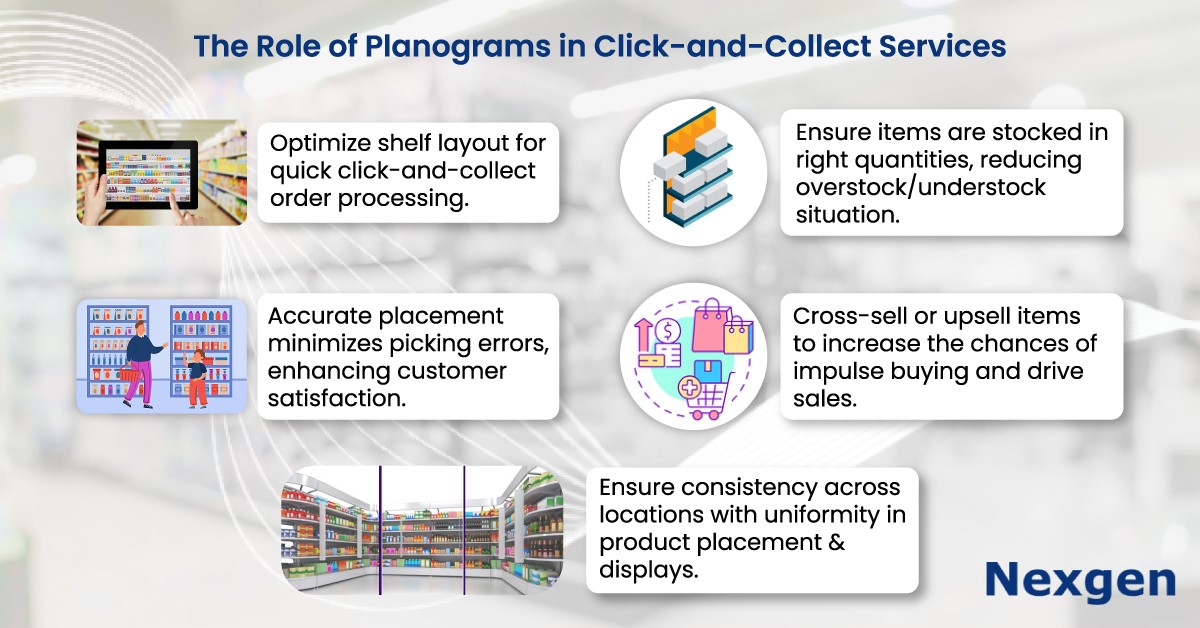Shoppers are constantly seeking convenience and efficiency when it comes to shopping. Click-and-collect services, also known as "buy online, pick up in-store" or BOPIS, have emerged as a popular solution to meet these demands. It enables shoppers to make purchases online and then collect their items from a physical store, eliminating the need to navigate crowded aisles and wait in long checkout lines. The success of click-and-collect services relies on various factors, and one key component is the implementation of shelf planning software, such as planograms.
How can Planograms Drive Click-and-Collet Service Sales?
Click-and-collect services have become an integral part of the modern retail business. They offer consumers a convenient and time-saving shopping option while providing retailers with an opportunity to boost sales. The role of planograms in optimizing this service cannot be overlook. They ensure products are well-organized, orders are fulfilled accurately, and customers enjoy a smooth and efficient experience. It enhances the shopping experience by making it easier for customers to find the products they need and boost sales. The following are some planogram ways to drive sales:

- Optimized product placement: Planograms help retailers organize their store shelves to ensure that items are placed strategically. For click-and-collect orders, this means that employees can quickly locate and retrieve the products on a customer's shopping list, reducing the time it takes to fulfill an order. In clothing stores, planograms dictate the arrangement of seasonal apparel, ensuring that popular styles and sizes are conveniently grouped near the click-and-collect counter. This not only enhances the convenience for click-and-collect shoppers but also reflects the store's commitment to providing a top-notch, customer-centric service.
- Improved employee productivity & reduced errors: Employees responsible for fulfilling click-and-collect orders can work more efficiently when products are organized according to planograms. This efficiency can lead to cost savings for the retailer and faster service for customers. Accurate product placement, as determined by planograms, minimizes the chances of picking errors. When customers place orders online, they expect to receive the correct items. A well-organized store, guided by planograms, help ensure order accuracy, which satisfies customers.
- Efficient inventory management: By following planograms, retailers can better manage their inventory. This ensures that products are stocked in the right quantities, reducing instances of overstock or understock. Proper inventory management benefits both in-store shoppers and click-and-collect customers.
- Cross-selling and upselling opportunities: Planograms can also suggest complementary or alternative products to be placed near the items a customer ordered. This can lead to increased sales as customers are enticed to add more to their cart. For instance, imagine a customer browsing for a moisturizer. You can position skincare products nearby, such as serums or sunscreen, encouraging the customer to complete their skincare routine. Additionally, you can offer personalized recommendations, suggesting premium or specialized products based on the customer's skin type or concerns. This not only enhances the customer's shopping experience but also increases the store's average transaction value.
- Consistency across locations: For retailers with multiple stores, planograms ensure a consistent shopping experience for customers, regardless of which location they visit. For instance, the placement of well-known pet food brands and accessories, such as collars, toys, and grooming supplies, remains standardized in all stores. This uniformity ensures that customers can easily locate their preferred pet products regardless of which store they visit, enhancing their shopping experience and fostering trust in the brand.
Overview of Nexgen POG
Nexgen POG is a robust and user-friendly cloud-based visual merchandising tool. It is designed for quick and efficient planogramming with minimal effort. Planogram in retail can be designed by easily dragging and dropping the products. The multi-device compatibility feature of POG allows you to obtain, share and edit planogram on any device, including your phone. It helps in designing store-specific planograms for increased product visibility and sales.
Get Your Free Trial Now!